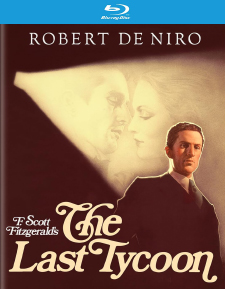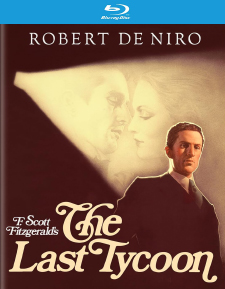Last Tycoon, The (Blu-ray Review)

Director
Elia KazanRelease Date(s)
1976 (November 28, 2023)Studio(s)
Paramount Pictures (Kino Lorber Studio Classics)- Film/Program Grade: B-
- Video Grade: A-
- Audio Grade: A
- Extras Grade: B
Review
The Last Tycoon (1976), adapted from F. Scott Fitzgerald’s unfinished novel, may be the most stilted movie ever made by the greatest collection of film talent. Produced by Sam Spiegel and directed by Elia Kazan, it was adapted by Harold Pinter with music by Maurice Jarre and stars Robert De Niro, Ingrid Boulting, Tony Curtis, Robert Mitchum, Jack Nicholson, Jeanne Moreau, Dana Andrews, Ray Milland, Theresa Russell, and Donald Pleasance.
The film was prompted in part by a big 1970s resurgence of interest in Hollywood’s classical period. The first serious film studies of directors like John Ford, Orson Welles, and Alfred Hitchcock were being published in English; actors like Humphrey Bogart, W.C. Fields, and Groucho Marx became cult figures on college campuses and at repertory screenings, and MGM’s retrospective That’s Entertainment! (1974), was a surprise box-office hit.
The film industry responded with scads of movies set during Hollywood’s Golden Age, among them: The Wild Party, Hearts of the West, The Day of the Locust (all 1975), Nickelodeon, Gable and Lombard, Won Ton Ton: The Dog Who Saved Hollywood, W.C. Fields and Me (all 1976). Their artistic merit varied wildly, but all were box-office disappointments when not abject failures.
In The Last Tycoon, Robert De Niro plays Monroe Stahr, a character based on Irving Thalberg, the “boy wonder” production chief at MGM until his sudden death in 1936 at just 37 years old. The studio Stahr oversees is never identified, but it was shot all over the Paramount lot as it existed in 1975-76. (The long-gone Western street on the backlot, with its distinctive mountain backdrop, appears briefly.) Thalberg was particularly lionized by Hollywood—they named an honorary Academy Award after him and he was the only producer Groucho Marx respected, for instance—but his dictatorial control over all aspects of production ran roughshod over creative writers and directors.
Like Thalberg, Stahr is a sickly boy wonder, whose creative genius has for years assured record profits for his studio. The Last Tycoon opens with the studio besieged with various calamites: an earthquake floods much of the lot, director Red Ridingwood (Dana Andrews) is having trouble with difficult, aging diva Didi (Jeanne Moreau), while her likewise middle-aged co-star, Rodriguez (Tony Curtis), is distracted by sexual dysfunction and mid-life crises. Older producer Pat Brady (Robert Mitchum), who discovered Stahr, is conspiring with the studio’s New York attorney, Fleishackler (Ray Milland), to usurp Stahr’s power over everybody, using threats by Brimmer (Jack Nicholson), the communist leader of the burgeoning Writer’s Guild, to bring about his downfall.
Meanwhile, Stahr becomes obsessed with a young woman, Kathleen Moore (Ingrid Boulting), who snuck onto the lot with her friend Edna (Anjelica Huston), Kathleen the spitting image of Stahr’s late movie star wife, Minna Davis, whose dressing room is preserved on the lot as a memorial.
The Last Tycoon has many interesting moments but can’t overcome several fundamental problems. The first is that its central character is an enigmatic creative genius, but the film never succeeds in getting inside his head or conveying how this genius manifests and convincing the audience that it justifies his total control over everything. The Amazing Howard Hughes (1976), yet another Hollywood-set film from this era (though done as a television mini-series) cast Tommy Lee Jones as the similarly eccentric, enigmatic filmmaker and studio head-millionaire Howard Hughes, yet somehow Jones’s portrayal, also emotionally unreadable, was somehow completely fascinating. De Niro, by contrast, captures Thalberg’s essence but comes off as lacking empathy, maddeningly circumspect, and repressively self-contained and emotionally hermetically sealed. Only once does the character come alive, when Stahr cleverly—if not quite believably—improvises a story during a meeting with George Boxley (Donald Pleasance), a respected literary figure too proud to “waste” his talent on the flickers. In this one scene Stahr, through his improvised little drama, expresses the innately visual language of film and its allure and how it operates differently from the written word, which the appreciative Boxley seems to get (at least temporarily).
The limitations of De Niro’s carefully measured but almost stillborn performance become especially obvious in the film’s last act, when Jack Nicholson turns up for a few scenes as Stahr’s communist rival. In conversations with Stahr, Nicholson’s Brimmer actually seems alive, a real living, breathing character, which makes De Niro look like a department store mannequin by comparison. Ingrid Boulting, former model and step-daughter of British filmmaker Roy Boulting, proves a limited actress along the lines of Jill Ireland, and her romantic scenes with De Niro are particularly lifeless, much of their dialogue coming off like bad Antonioni or Resnais:
Kathleen: “I can never get used to the way night falls here. So fast. There’s no twilight. Is there?”
Stahr: “Not really. No. It’s so sudden.”
Kathleen: “Listen.”
Stahr: “What?”
Kathleen: “Nothing.”
This was Elia Kazan’s final film. One of the great talents of the American theater and co-founder of the Actors Studio, his movies are most notable for the performances he directed: Marlon Brando in A Streetcar Named Desire and On the Waterfront, James Dean and Julie Harris in East of Eden, Montgomery Clift in Wild River, etc. His blocking of these actors within the frame is also always interesting, though visually his pictures are erratic and more dependent on Kazan’s cinematographers. Regardless, despite the wildly diverse acting styles—Oh, to have been a fly on the wall during the Mitchum-De Niro scenes!—the multi-generational cast play off one another quite well. Nicholson, Mitchum, Pleasance, and Theresa Russell, she as Mitchum’s adult daughter, are particularly good, and fine actors like Seymour Cassel (as a seal trainer) and Anjelica Huston are excellent in small parts. Visually, however, the film, shot by Victor J. Kemper, can’t remotely compare to John Schlesinger’s The Day of the Locust (shot by Conrad Hall), which has many uniquely, visually startling sequences. Further, the audience never learns much about the films in production at the studio, their relative importance, or even the basics of how they’re getting made (or why we should care).
Indeed, while the film captures the period, vague as it is, well enough, it’s a little off throughout, particularly with its film-within-the-film scenes and, other than Thalberg, does not really reference specific films, filmmakers, stars, etc. In retrospect, Stahr’s dismissive attitude toward all creative people other than himself—he’s condescending toward director Ridingwood and refers to all writers as former gag men—casts him in the same self-made “genius” mold as an Elon Musk or Jeff Bezos.
Kino’s new Blu-ray sources a 4K scan of the original 35 mm camera negative; the film looks brand-new, almost. Not mentioned on the packaging is the equally impressive audio, in DTS-HD Master Audio 5.1 and 2.0 mixes, which really bring out Maurice Jarre’s lush musical score. (The film may have had a few premiere engagements in stereo, but surely most original prints were mono.) Included in this release is about 90 seconds of exit music following the end titles. Optional English subtitles are included on this Region “A” disc.
There’s but a single extra feature (no trailer), but it gives much added value to this release: a new audio commentary track by film historian Joseph McBride, editor of Filmmakers on Filmmaking. His rich track goes into considerable detail about the book and its adaptation, putting the film and its setting into 1970s and 1930s industrial context. I was particularly fascinated by McBride’s take on Kazan’s tarnished reputation, including Kazan’s controversial 1999 honorary Oscar. McBride persuasively argues that while an award for the merit of a particular film is one thing, but a lifetime achievement award, by definition, covers a lifetime, which in Kazan’s case includes informing on people and ruining careers.
The Last Tycoon is an ambitious failure, but remains fascinating on many levels. That, coupled with Joseph McBride’s commentary track, often more interesting than the film itself, make this one a recommended release.
- Stuart Galbraith IV

